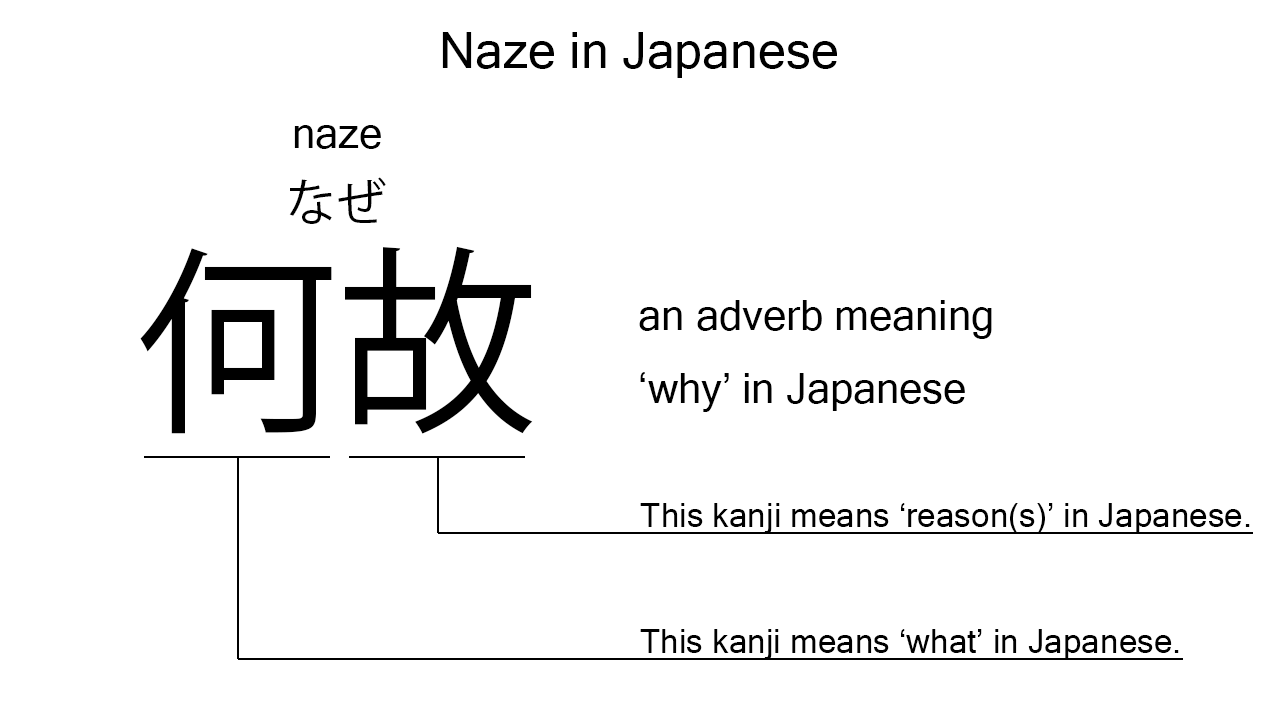What does “naze” mean in Japanese?
Native speakers say “naze” normally to mean ‘why’ in Japanese. Probably, some Japanese learners know this word as it is sometimes used in Japanese conversations. In this blog post, however, I will explain this word in detail based on its kanji expression. And also, I will explain how to use it through example sentences. My explanations would help Japanese learners understand “naze” more clearly. Then, let’s get started!
Contents
Definition and meaning of “naze”
Let me start with the definition and meaning of “naze”.
- naze – 何故 (なぜ) : an adverb meaning ‘why’ in Japanese.
Native speakers use this adverb to make why questions in Japanese. So, the usage is similar to that of “why” in English. However, they are a bit different in terms of flexibility. Word orders in Japanese are very flexible, so the Japanese adverb does not necessarily come to the beginning of a sentence to make a question.
The definition and meaning are simple and clear. To understand this adverb more clearly, however, let me explain its kanji characters in detail, one by one.
What does “naze” literally mean in Japanese?
The kanji expression of “naze” consists of the following two kanji characters:
- 何 : a kanji character widely used to mean ‘what’ in Japanese.
- 故 : a kanji character used to mean ‘reason’ in Japanese.
These two kanji characters tell us that “naze” literally means ‘what reason’ in Japanese. This literal interpretation is very close to the actual meaning.

When we meet new kanji expressions, we should check their kanji characters in detail to understand their meanings clearly and deeply. In many cases, kanji characters tell us a lot about the meanings of the expressions they form. Actually, here, we could get the better understanding of “naze” through the detailed kanji check above.
So far, I’ve explained the definition and meaning of “naze” together with its kanji characters. Then, let me explain how to use it through the example sentences below.
Example #1: how to say “why” in Japanese
naze kanojo wa nippon ni iki tai no – 何故彼女は日本に行きたいの (なぜかのじょはにっぽんにいきたいの)
Why does she want to go to Japan?
Below are the new words used in the example sentence.
- kanojo – 彼女 (かのじょ) : a pronoun meaning ‘she’ in Japanese.
- wa – は : a binding particle working as a case marker or topic marker. In the example, this works after “kanojo” to make the subject in the sentence.
- nippon – 日本 (にっぽん) : a noun meaning ‘Japan’ in Japanese.
- ni – に : a case particle used to say where someone or something goes. In the example, this is used after “nippon” to say where she wants to go.
- iki – 行き (いき) : one conjugation of the verb, “iku“, which means ‘to go’ in Japanese. In the example, it has been conjugated for the better connection with its following word.
- tai – たい : an auxiliary verb used after a verb to make its desire form. In the example, this is used after “iki” to make its desire form, “iki tai”, which means ‘to want to go’ in Japanese.
- no – の : a sentence-ending particle used to make a question. As the definition suggests, this is used at the end of the sentence to make the question.
This is a typical usage of “naze”. In this example, it works at the beginning of the sentence to mean ‘why’ in Japanese.
Example #2: another usage of “naze”
kanojo tachi wa naze nippon no geijutsu wo manabu no – 彼女達は何故日本の芸術を学ぶの (かのじょたちはなぜにっぽんのげいじゅつをまなぶの)
Why do they study Japanese art?
Below are the new words used in the example sentence.
- tachi – 達 (たち) : a suffix used after a noun or pronoun to make its plural form. In the example, this is used after “kanojo” to make its plural form, “kanojo tachi”, which means ‘they’ in Japanese. Learn more about Japanese plural.
- no – の : a case particle joining two nouns. Normally, the first one can work as a modifier to describe the second. In the example, this works to join “nippon” and “geijutsu”. The formed phrase literally means ‘Japanese art’ in Japanese.
- geijutsu – 芸術 (げいじゅつ) : a noun meaning ‘art’ in Japanese.
- wo – を : a case particle used to make the object word in a sentence. In the example, this is used after “nippon no geijutsu” to make the object in the sentence.
- manabu – 学ぶ (まなぶ) : a verb meaning ‘to study’ in Japanese.
This is another typical usage of “naze”. In this example, it works in the middle of the sentence to say “why” in Japanese. When we want to make why questions in Japanese, anyway, this adverb is a very good option.
Summary
In this blog post, I’ve explained the definition and meaning of “naze” in detail based on its kanji expression. And also, I’ve explained how to use it through the example sentences. Let me summarize them as follows.
- naze – 何故 (なぜ) : an adverb meaning ‘why’ in Japanese. These two kanji characters literally mean ‘what reason’ in Japanese. This literal interpretation is very close to the actual meaning. Native speakers use this adverb to make why questions in Japanese. So, the usage is similar to that of “why” in English. However, they are a bit different in terms of flexibility. Word orders in Japanese are very flexible, so this Japanese adverb does not necessarily come to the beginning of a sentence to make a question.
Hope my explanations are understandable and helpful for Japanese learners.